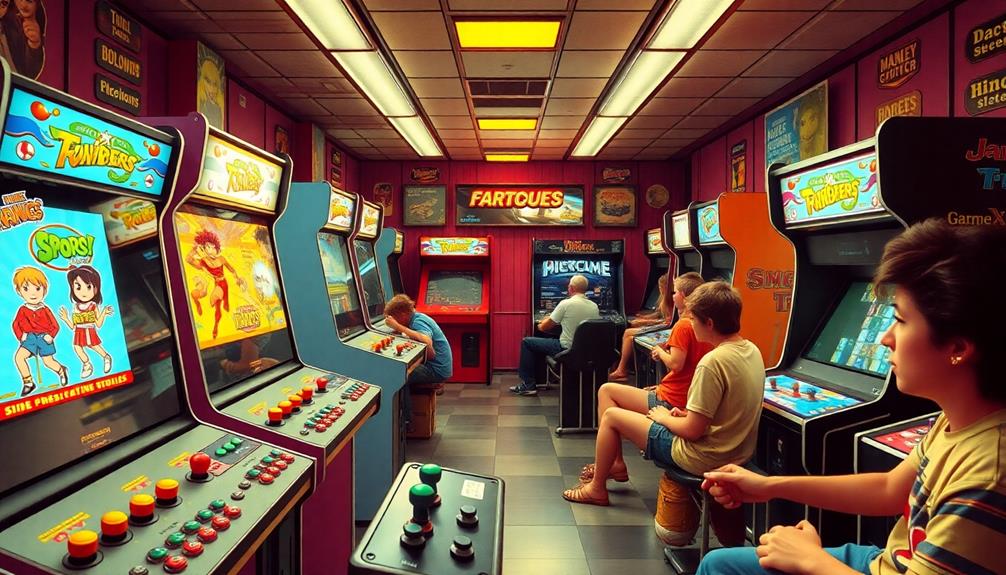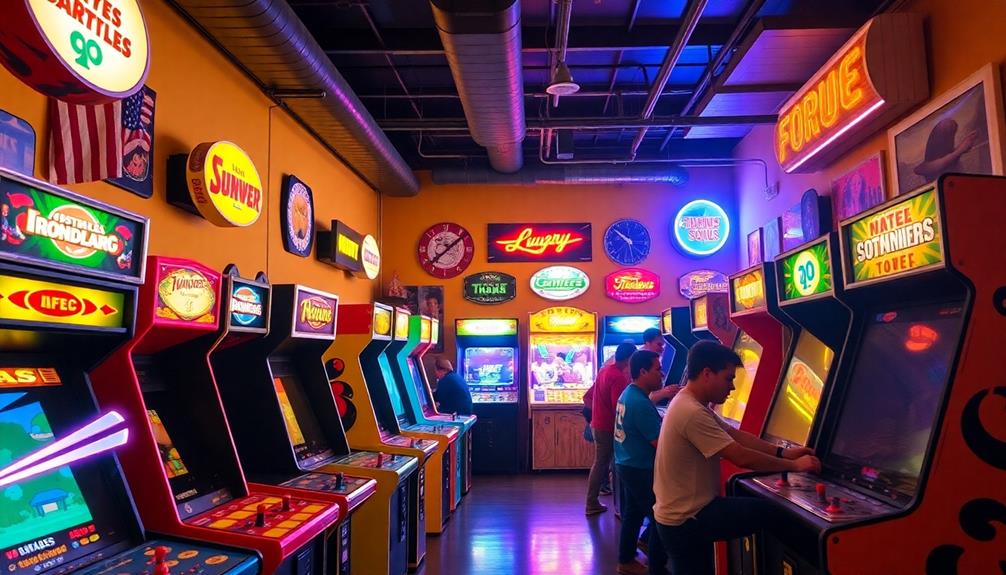In the 1980s, iconic arcade games like Pac-Man, Donkey Kong, and Ms. Pac-Man were dominating gaming centers everywhere. Space Invaders and Galaga were also popular, offering intense gameplay and competition. These games broke technological barriers with vibrant graphics and audio, pulling players into thrilling worlds. Players would bond over competitive matches and high scores, creating a lively community. This period not only defined the gaming landscape but also had a long-lasting cultural influence. If you want to learn more about these legendary games and their impact, there is plenty to explore about their legacy.
Key Takeaways
- Pac-Man (1980) became a cultural icon, selling over 400,000 cabinets and grossing over $1 billion by 1981.
- Donkey Kong (1981) introduced Mario and set new standards for platform games with its precision jumping mechanics.
- Ms. Pac-Man (1982) expanded on its predecessor's gameplay, selling approximately 115,000 units and enhancing maze chase mechanics.
- Space Invaders (1978) revolutionized the shooter genre, inspiring countless imitators and generating around $2 billion in revenue.
- Galaga and Asteroids were significant titles that introduced engaging gameplay and became staples in arcade venues during the 80s.
Overview of 80s Arcade Games
The excitement of the 80s arcade scene was palpable, as this era marked a significant boom in the gaming industry. Classic 80s arcade games dominated the landscape, generating over $8 billion in revenue by 1982—outpacing both pop music and Hollywood films.
You'd see people flocking to arcades, captivated by innovative titles like *Space Invaders*, which revolutionized the shooter genre and introduced competitive gameplay that kept you coming back for more. These games laid the groundwork for future gaming innovations, much like the advancements seen in modern best rated pinball machines of 2024, showcasing the evolution of gaming experiences.
Games like *Pac-Man* and *Donkey Kong* became cultural phenomena, establishing memorable characters and gameplay mechanics that influenced future designs. You could easily lose track of time trying to beat your high score or challenge friends in head-to-head competition.
The introduction of color graphics and improved audio during this decade enhanced your gaming experience, making it more immersive than ever.
As the arcade landscape expanded rapidly, the number of venues nearly doubled from 1980 to 1982, leading to over 24,000 full arcades across North America. This growth not only reflected the popularity of arcade games but also helped foster a vibrant community of gamers, all enthusiastic to share their passion for the thrilling experiences these games offered.
Iconic Titles of the Decade
Let's explore the iconic titles that defined arcade gaming in the 80s, from Pac-Man's maze-chomping frenzy to Space Invaders' groundbreaking shooter mechanics.
These games not only captivated players but also introduced technological innovations and left a lasting cultural impact.
Many of these classic games have inspired modern adaptations and even influenced the design of best arcade machines for home game rooms.
You'll see how each title contributed to the vibrant landscape of arcade gaming during this unforgettable decade.
Most Popular Games
During the 1980s, arcade games exploded in popularity, enchanting players with innovative gameplay and unforgettable characters. The decade was defined by a few standout titles that captured your attention and became cultural icons, much like how Paula Deen's Wedding Highlights showcased memorable moments filled with love and charm.
The classic arcade experience wouldn't have been the same without these games that not only entertained but also shaped the industry.
- Pac-Man: Released in 1980, this game became a cultural phenomenon, selling over 400,000 arcade cabinets and grossing over $1 billion by 1981. It's often considered the first arcade game that truly appealed to a broad audience.
- Donkey Kong: Launched in 1981, it introduced Mario and set the stage for platform games, focusing on rescuing a princess from a giant gorilla.
- Ms. Pac-Man: This beloved sequel, released in 1982, featured new mazes and enemy behaviors, selling approximately 115,000 units and earning acclaim as one of the best arcade sequels ever created.
These iconic titles alone helped video games account for a significant portion of the entertainment landscape during the decade, paving the way for future innovations.
Technological Innovations
Transforming the arcade experience, technological innovations in the 80s redefined how players interacted with games. The introduction of RGB color graphics and advanced audio technology in titles like *Pac-Man* (1980) and *Donkey Kong* (1981) captivated you with engaging visuals and immersive soundscapes.
As you played, you couldn't help but appreciate the evolution that games like *Space Invaders* (1978) set in motion, paving the way for intense gameplay in *Galaga* (1981). The decade's advancements mirrored the cultural impact of trends like astrology and attractiveness, as both greatly influenced public perception and engagement.
Innovative vector graphics in *Tempest* (1981) showcased the decade's commitment to pushing visual boundaries, while the dual joystick controls in *Robotron: 2084* (1982) revolutionized gameplay mechanics, allowing you to aim and shoot simultaneously.
This enhancement brought a thrilling intensity to arcade action games, making each session more exhilarating.
Moreover, technological advancements in game design, such as the maze chase mechanics in *Ms. Pac-Man* (1982), expanded gameplay styles and appealed to a broad audience.
These innovations not only enriched your gaming experience but also laid the groundwork for future developments in the industry, setting the stage for the arcade evolution that followed.
Cultural Impact
In the vibrant landscape of the 80s, iconic arcade games became cultural touchstones that defined a generation. These popular games weren't just entertainment; they transformed the way you and your friends interacted with video gaming. Titles like *Pac-Man*, *Donkey Kong*, and *Space Invaders* shaped not only gaming culture but also influenced movies and music, creating a lasting legacy.
The decade was characterized by the emergence of various trends, including a fascination with celebrity lifestyles, as seen in the way public figures embraced gaming culture and incorporated it into their personas, much like Kourtney Kardashian's nude photo scandal impacting her reputation.
- *Pac-Man* introduced the world to gaming mascots, selling over 400,000 cabinets by 1981.
- *Space Invaders* revolutionized the shooter genre, generating around $2 billion in revenue and inspiring countless imitators.
- *Ms. Pac-Man* refined its predecessor, becoming one of the best arcade sequels with 115,000 units sold.
The cultural phenomenon of these arcade games extended far beyond the arcade. By 1981, over 35 million gamers flocked to video game arcades across the U.S., making them social hubs of the decade.
With characters like Mario making their debuts, the impact of these games is still felt today. The 80s showed us that arcade games could be more than just a pastime; they could unite communities and create shared experiences that would resonate for years to come.
Gameplay Mechanics and Innovations

As arcade games gained popularity in the 80s, developers explored innovative gameplay mechanics that kept players engaged and coming back for more. Titles like *Space Invaders* introduced multiple lives, encouraging extended play and deeper engagement. Meanwhile, *Pac-Man* popularized maze chase gameplay, showcasing unique enemy behaviors and strategic power-ups that added layers to the experience.
The gameplay of *Donkey Kong* emphasized precision and skill, introducing jumping mechanics that laid the groundwork for future platform games. Additionally, innovative control schemes, such as the dual joystick setup in *Robotron 2084*, challenged players to aim and shoot simultaneously, enhancing the action experience. Games like *Dig Dug* combined strategy with traditional shooting elements, featuring unique mechanics involving digging and inflating enemies.
Here's a quick look at some key innovations:
| Game Title | Gameplay Innovation |
|---|---|
| Space Invaders | Multiple lives enhancing engagement |
| Pac-Man | Maze chase with unique enemy behaviors |
| Donkey Kong | Jumping mechanics for precision |
| Robotron 2084 | Dual joystick control scheme |
| Dig Dug | Digging and inflating mechanics |
These gameplay mechanics paved the way for the evolution of arcade games throughout the decade.
Cultural Impact on Society

Arcade games frequently shaped the cultural landscape of the 80s, leaving a lasting impact on society. They weren't just games; they became cultural icons that defined a generation. The influence of these games can be compared to the role of utilitarian thinkers' declarations in shaping moral perspectives, as both sought to enhance collective experiences. You might remember the buzz of crowded arcades, where friends gathered to compete and share strategies.
- Pac-Mania took over, turning Pac-Man into an enduring cultural icon.
- By 1981, over 35 million gamers flocked to video game arcades in the U.S., showcasing their immense popularity.
- The rise of these games even led to a $400 million revenue drop for the music industry, underscoring their cultural influence.
Films like "Tron" and shows like "The Goldbergs" highlighted arcade games, weaving them into the fabric of entertainment. This phenomenon fostered nostalgia, as many people look back fondly on those arcade days.
The impact of arcade games still resonates today, inspiring modern gaming designs and retro-themed events. As you reflect on the 80s, it's clear that arcade games weren't just a trend; they became a defining part of popular culture, leaving an indelible mark that continues to influence society.
Business Growth and Market Trends

During the early 80s, the arcade gaming industry experienced explosive growth that transformed the entertainment landscape. You'd see the number of video game arcades in the U.S. double from 1980 to 1982, peaking at 10,000 locations. This boom led to arcade machine sales skyrocketing from $50 million in 1978 to $900 million by 1981, highlighting the remarkable business growth in this sector.
| Year | Arcade Locations | Industry's Revenue |
|---|---|---|
| 1980 | 5,000 | $50 million |
| 1981 | 10,000 | $900 million |
| 1982 | 24,000 | $8 billion |
Community Engagement and Nostalgia

When you think back to the 80s, which arcade games spark your fondest memories? From the colorful graphics to the catchy soundtracks, these games created lasting impressions.
Sharing your favorite titles, like Pac-Man or Donkey Kong, can connect you with others who experienced the thrill of those classic games.
These shared gaming moments not only celebrate nostalgia but also strengthen the bonds within the retro gaming community, making it a unique part of our collective emotional reflections on the past.
Shared Gaming Memories
Nostalgia for the 80s arcade scene thrives in community forums where players enthusiastically share their cherished gaming memories. You might find yourself diving into discussions about how iconic arcade games like *Pac-Man* and *Donkey Kong* shaped your childhood.
These conversations create a sense of belonging, as everyone recounts their experiences chasing high scores and revealing the magic of classic gameplay. The vibrant sounds and pixelated graphics of that era evoke feelings similar to those inspired by the radiant melodies in Blue Skies and Lemonade, capturing the joy of simpler times.
- Reminiscing about the thrill of hearing that "game over" sound after a fierce battle in Robotron: 2084
- Swapping stories about the friendships forged over competitive matches in Joust
- Advocating for forgotten classics that deserve recognition and a place in modern retrospectives.
These shared memories not only highlight the impact of technology and graphics from that era but also rekindle a spirit of camaraderie among players.
You can almost feel the excitement of those arcade halls, filled with laughter and friendly competition. As you engage with fellow fans, it becomes clear that these nostalgic reflections connect us all, reminding us of the joy and community that 80s arcade games created.
Favorite Classic Titles
Many players fondly remember their favorite classic arcade titles, each one sparking unique memories and emotions. Iconic games like *Pac-Man* and *Donkey Kong* not only dominated the arcades but also became cultural phenomena.
With over 400,000 *Pac-Man* cabinets sold and more than $1 billion generated by 1981, the game's popularity is undeniable. Meanwhile, *Donkey Kong* introduced Mario, shaping the future of platform games and video game design. The creativity behind these games mirrors the principles of user-centric solutions emphasized in design thinking, showcasing how innovative ideas can capture the hearts of players.
Arcade games like *Galaga* and *Asteroids* showcased innovative mechanics that kept you coming back for more. *Asteroids* even became Atari's most successful coin-operated game.
Competition played a huge part in the arcade experience, as titles like *Robotron: 2084* and *Joust* encouraged high score battles among friends, fostering a sense of community.
Nostalgia for these classic titles remains strong today. You likely find yourself reminiscing with fellow enthusiasts about those exhilarating moments spent in arcades, sharing your top picks in online forums.
The joy and excitement of those games continue to spark conversations, proving that the legacy of 80s arcade games still resonates powerfully in today's gaming culture.
Legacy of 80s Arcade Games

The legacy of 80s arcade games resonates through the gaming world today, as titles like *Pac-Man*, *Donkey Kong*, and *Galaga* not only shaped gameplay mechanics but also laid the groundwork for enduring franchises. By generating over $8 billion in revenue by 1982, arcade games surpassed the music and film industries, showcasing their profound cultural impact.
The financial success of these games can be compared to the importance of having a solid budget plan in managing money effectively.
You can see the influence of these classics in modern gaming through:
- Innovative mechanics that inspire game design
- A vibrant arcade culture fostering community engagement
- Nostalgic remakes and events celebrating retro titles
The popularity of 80s arcade games led to social interactions, with over 35 million gamers visiting arcades in the U.S. by 1981.
This sense of community remains a pillar of gaming culture today, as players continue to embrace the nostalgia of those classic titles. As you immerse yourself in contemporary games, you might notice how the essence of 80s arcade games still permeates through gameplay, aesthetics, and social experiences.
Their legacy not only shaped the past but also continues to influence the future of gaming, ensuring that these iconic games remain relevant in the ever-evolving landscape.
Frequently Asked Questions
What Arcade Games Came Out in the 1980S?
In the 1980s, you experienced a gaming revolution with classics like *Pac-Man*, *Donkey Kong*, and *Galaga*. These games captivated players, introducing innovative mechanics that shaped the future of arcade gaming and your gaming nostalgia.
Which Popular Arcade Game Hit Shelves in 1980?
Did you know *Pac-Man* grossed over $1 billion in arcade revenue by 1981? This iconic game hit shelves in 1980, enchanting players with its innovative maze-running gameplay and memorable characters like Pac-Man and the colorful ghosts.
Which 1980S Arcade Game Appealed to Almost Everyone?
You'd find that Pac-Man appealed to almost everyone. Its simple yet addictive gameplay, combined with its charming character, attracted players of all ages, making it a cornerstone of arcade culture during the 1980s.
What Was the First Popular Arcade Games?
Picture yourself in a dimly lit arcade; *Pong* catches your eye. It's the first popular arcade game, igniting a gaming revolution. You can't help but feel the excitement of its simple yet addictive gameplay.
Conclusion
As you step back into the neon-lit domain of 80s arcade games, you can almost hear the chime of coins and the thrill of victory echoing in your mind. These iconic titles didn't just entertain; they sparked a cultural revolution, weaving themselves into the fabric of society. So, next time you spot a vintage arcade cabinet, let the nostalgia wash over you, and remember the magic of that golden era where every game was a new adventure waiting to be conquered.









